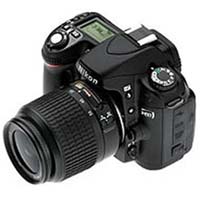Apr 13, 2025
Apr 13, 2025
 In digital photography, dust is the enemy. It's especially true for owners of interchangeable lens digital cameras (DSLRs), the sales of which are growing faster than for any other type.
In digital photography, dust is the enemy. It's especially true for owners of interchangeable lens digital cameras (DSLRs), the sales of which are growing faster than for any other type.
When dust gets inside the camera, it ends up on the sensor - the camera's main light-gathering chip - and can show up on your digital photographs as spots. Some of these spots are large, some small, some faint and some dark.
No matter how the spots show up, they mean more work for you when processing your photographs, as you'll be left with the chore of trying to remove the spots using software. That's why dealing with dust is a challenge worth taking up for everyone who uses a digital camera. The approach you take will depend upon the type of photography you do and how fastidious you want to be.
On digital photographs viewed on your computer screen, dust will typically be most apparent in bright areas of uniform color, such as the sky. Dust particles will typically appear as amorphous discolorations as large as a pea or as small as pinhead. Sometimes dust or debris can show up as a dark sliver on photographs.
In all cases, dust will appear in exactly the same place on several photographs that you've taken in succession, so if you have a question about whether you're seeing dust on your images, open several photos as once and compare them when zoomed in to 100 percent.
The very best way to identify dust on your sensor is to shoot pictures of the sky while your camera's aperture is set to f/22. Consult your camera manual, if necessary, to learn how to set your camera's aperture. Then look at those pictures on your computer monitor. If there's dust on your sensor, you'll definitely see it after this operation.
Once you've identified that you have a dust problem, you need to tackle it so that your images are spot-free again. There are several methods to remove dust from your DSLR's sensor.
The easiest - but sometimes least effective - is to purchase what's known as an air blower bulb from your local or online camera store.
An air blower bulb is nothing more than a bulbous rubber device with a nozzle. You squeeze the bulb to squirt air out of the nozzle. These are generally inexpensive.
Keep in mind that larger ones such as the well-known Giottos Rocket Blower are often the most effective, as they emit the most air. It's a good idea for every digital camera owner to have an air blower, since they're also effective for cleaning the outside of the camera.
Once you have your air blower, remove your camera's lens, and hold the camera above your head with the lens opening facing down, toward you, so that you can look up into it.
Insert the nozzle end just slightly into the lens mount opening, being careful not to touch anything with it, and then give squeeze the bulb a few times to blow bursts of air into the camera. What you're doing at this point is simply cleaning the mirror and lens box assembly. Occasionally this is all you need to do to.
The next line of defence is to expose your camera's sensitive sensor so that you can use the air blower to remove dust from it more directly. Each DSLR maker has its own way of allowing you to expose the sensor for this type of cleaning.
When the air blower just doesn't remove enough dust to satisfy you, there are other, more serious measures you can take, but first some words of caution. To begin with, it's very difficult to remove all particles of dust from the sensor, so it's best to resist the urge to be a perfectionist when it comes to total dust removal.
Second, no dust removal method other than using the air blower is officially sanctioned by camera makers, which universally recommend that you send your camera in to the manufacturer's nearest service centre for maintenance.
And finally, many dust particles that show up readily at f/22 are not visible at all on images taken at more commonly-used apertures, so don't worry about dust particles that don't actually affect your pictures.
That said, there are several products on the market today designed for those who require a very clean DSLR sensor.
VisibleDust makes a well-regarded Arctic Butterfly product designed to clean the sensors of most DSLRs, and Copper Hill Images makes another popular Sensor Cleaning Kit that contains all of the tools you need to get your sensor squeaky clean.
DSLR users will always need to take care to ensure that large amounts of dust do not enter the lens mounts of their cameras, but manual sensor cleaning may be a thing of the past a few years from now. Already some of the big camera makers -Nikon, Canon, and Olympus - have announced models that incorporate special anti-dust mechanisms that activate each time you turn on the camera. Whether these anti-dust systems will completely take the place of necessary manual cleanings remains to be seen, but anything helps in the fight against dust.
01-Sep-2007
More by : Jay Dougherty